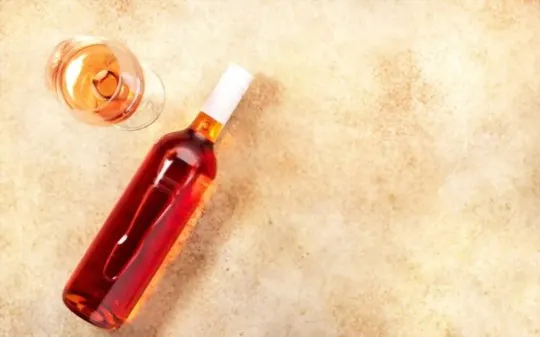Are you curious what White Zinfandel tastes like?
Then keep reading, because we’re going to provide a comprehensive guide that will answer all your questions.
From its origins to tasting notes and food pairings, this post has it all!
If you’ve ever been perplexed by the delicate flavor of white zinfandel or wanted to know more about why it’s such a popular wine choice, then look no further.
We’ll explain everything so you can sip confidently knowing exactly what flavors and aromas are in this light-bodied rosé wine.
What is White Zinfandel?

White Zinfandel is a type of wine that is made from the red grape known as Zinfandel.
The difference between regular Zinfandel and White Zinfandel is in the way they are made.
Regular Zinfandel is made with the skins and seeds of the grapes, whereas White Zinfandel is made without them.
White Zinfandel was first introduced in California in the 1970s when winemakers were experimenting with different techniques to produce wines that would appeal to a wider audience.
They discovered that by removing the skins and seeds from the grape juice before fermentation, they could produce a wine that had a lighter color and sweeter taste than traditional red wines.
White Zinfandel has become very popular over the years, especially among those who prefer sweeter wines.
It is generally considered to be a low-alcohol wine with a light body, making it perfect for casual occasions such as picnics or barbecues.
Some people mistakenly believe that White Zinfandel is an inferior wine because of its sweetness and lightness.
However, this couldn’t be further from the truth.
White Zinfandel is a high-quality wine that requires skill and expertise to produce.
What Does White Zinfandel Taste Like?

White Zinfandel is a light, sweet wine that has become increasingly popular over the years.
It is made from a red grape variety known as Zinfandel, but unlike other Zinfandels, this wine is fermented with minimal contact with the skins, resulting in a lighter color and sweeter taste.
The first thing you will notice about White Zinfandel is its pink hue.
It can range from pale pink to deep salmon in color depending on the winemaking process.
When you take a sip, you’ll likely experience a burst of sweetness on your palate.
The wine’s sugar content varies, but it’s generally considered to be one of the sweeter wines available.
White Zinfandel also has notes of red fruit, such as raspberry or strawberry.
This comes from the fact that it’s made from the same grape variety as red Zinfandel wine.
However, these fruity flavors are much more subtle in White Zinfandel than in its red counterpart.
You may also detect hints of citrus or floral notes.
Overall, White Zinfandel is an easy-to-drink wine that offers a refreshing change of pace from drier varietals.
Whether you’re just starting out as a wine drinker or simply prefer sweeter wines, White Zinfandel is an excellent option.
Factors that Affect the Taste of White Zinfandel
If you’ve ever tasted white Zinfandel, you’d agree that its unique taste is quite hard to miss.
It’s sweet, crisp and refreshing with a fruity aroma that is unmistakable in any wine lineup.
However, several factors contribute to white Zinfandel’s taste profile.
The first significant factor affecting the taste of white Zinfandel is the grape variety used in production.
White Zinfandel wine, which is often mistaken for a white wine, is made from red grapes – the same ones used to produce classic California-style red wines.
The skin color of grapes determines the color of their juice – green for white grapes and red for black grapes – resulting in a pink hue characteristic of many rosé wines.
The sweetness or dryness level of white Zinfandel also influences its overall taste profile.
Unlike typical red or white wines with a standard sweetness scale, winemakers determine how sweet or dry a bottle of white zin should be based on their personal preference or their target market’s preferences.
Another essential factor affecting the taste of this beloved varietal is how it has been produced – meaning the type of fermentation used during production.
Using malolactic fermentation results in a buttery flavor profile characterized by butterscotch, caramelized milk candy flavors while acidic fermentations result in tart fruit flavors.
Acidity levels in White Zinfandel play an important role as well – high acid levels give rise to a bright and crisp flavor while low acidity results in mellow and smoother notes.
In addition to that, alcohol content plays its part too–the higher alcohol content gives rise to a mild burning sensation more noticeable than lower-alcohol varieties.
With an understanding of what factors influence White Zinfandel’s flavour profile one can easily appreciate why there is such variation from bottle-to-bottle with each brewer bringing something new to its custom recipe.
How to Serve White Zinfandel?

To serve white Zinfandel, it is important to consider the right temperature.
Typically, it should be served chilled but not too cold as it can dampen the flavors.
A good range is around 45-50°F (7-10°C).
You can achieve this by placing the bottle in a refrigerator or an ice bucket for around half an hour before serving.
The next step is to use the right glassware.
Choosing a glass with a narrow rim helps concentrate the aromas and flavors of the wine towards your nose and mouth.
A tulip-shaped or balloon-shaped glass are good options for white Zinfandel.
When pouring, fill the glass about one-third of the way full to allow room for swirling and releasing aromas.
Swirling helps release the wine’s aromas and flavors while also oxidizing it slightly to improve its taste.
It would be best if you also avoided serving too much white Zinfandel at once as it may warm up over time.
Finally, enjoy your white Zinfandel with food or on its own according to your preference.
It is a versatile wine that pairs well with various dishes such as seafood, salad, spicy dishes, and even desserts like cheesecake.
In summary, serving white Zinfandel involves chilling it to the right temperature, using appropriate glassware, pouring appropriately to allow for swirling and releasing aromas while avoiding overfilling and pairing it accordingly with your preferred dish choice.
Food Pairings with White Zinfandel
White Zinfandel is a versatile wine that pairs well with a wide variety of foods.
Whether you’re having dinner with friends or enjoying a romantic meal for two, there’s sure to be a White Zinfandel pairing that will enhance your dining experience.
To make things easier, we’ve created a table below to give you some ideas for food pairings.
Keep in mind that these are only suggestions and you should always choose the pairing that works best for you.
When it comes to spicy foods, it’s important to choose a sweeter wine like a White Zinfandel.
This will help balance out the heat and bring out the flavors in the dish.
If you’re serving grilled meats or seafood, look for a medium to light-bodied white zin.
For cheese pairings, off-dry white zins can complement aged cheeses like cheddar or gouda, while sweet white zins can pair well with softer cheeses like brie or camembert.
Remember that when pairing food and wine, there are no rules set in stone.
Experiment with different combinations and have fun discovering new flavor profiles.
Where to Buy White Zinfandel and How to Store It?

To buy white zinfandel and store it, you can find this wine easily in most wine shops or liquor stores.
You can also search for it online, where many retailers sell white zinfandel varieties of different brands and prices.
Some online marketplaces like Wine.
com Amazon, Total Wine & More, etc.
, offer delivery to your doorstep.
It is easy to store white zinfandel as well.
Keep the bottle in a cool, dry place like your pantry or cellar away from direct sunlight, and it will keep well for up to two years after purchase.
However, once opened, it is crucial to seal the bottle properly or transfer it into airtight containers to prevent oxidation, which will spoil the flavor of the wine.
Overall, buying and storing white zinfandel is an easy process.
Whether you are looking for convenience by ordering online or prefer shopping at a local wine store; just make sure the bottle is kept cool and away from direct sunlight while stored in order preserve its captivating taste.
Conclusion
Starting off with Conclusion, it can be said that White Zinfandel is a popular pink wine known for its sweet flavour and light body.
It is a versatile wine that can be paired with various cuisines, making it a favourite amongst wine connoisseurs.
Its affordability and accessibility make it easy for people to get their hands on this delicate wine.
When considering buying white zinfandel, keep in mind the storage conditions to ensure that you don’t compromise on its quality.
Avoid keeping the bottle in direct sunlight or extreme temperatures.
Store them sideways to allow proper contact between the cork and wine, preventing any air leaks.
Also, try not to store opened bottles for too long as they lose their flavour.

What Does White Zinfandel Taste Like? A Comprehensive Guide
Ingredients
- White Zinfandel
- Ingredients from your selected recipes
Instructions
- Select ingredients that work well together.
- Use a recipe or method that will enhance their natural taste.
- Taste and adjust the recipe as needed to achieve the desired flavor.

Carrie is a food writer and editor with more than 15 years of experience. She has worked for some of the biggest names in the food industry, including Bon Appétit, Food & Wine, and Martha Stewart Living.
As the Editor in Chief of IntroChicago.com, Carrie oversees all of the content on the site. She also manages the team of contributing writers and editors, who help to create delicious recipes, helpful tips, and informative articles that you’ll find on the site.
A native of the Chicago area, Carrie is passionate about all things food. She loves trying new restaurants and experimenting with new recipes in her kitchen. She’s also a graduate of the Culinary Institute of America, so she knows a thing or two about food!
